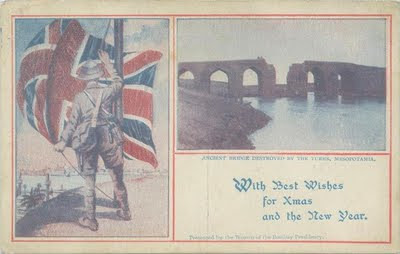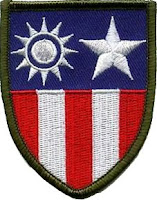Coming Monday happens to be holiday here in India to be celebrated as Ramzan, an important Muslim festival. Thus, I will try to post 3 articles if possible enjoying my holidays at home.
Today's article is about British Indian Army or more popularly known as Indian Expeditionary Force's participation in World War I in Mesopotamian and Persian campaign.
The Middle Eastern theatre of World War I was the scene of action between 2 November, 1914, and 29 October, 1918. This theatre encompassed the largest territory of all the theatres of the war. There were five main campaigns: the Sinai and Palestine Campaign, the Mesopotamian Campaign, the Caucasus Campaign, the Persian Campaign and the Gallipoli Campaign. Indian army participated in all of campaigns but today's focus is only two of them based on articles that I am going to produce here.
Shown below is a postcard printed and published by Times of India press, Bombay for the Women branch of the Bombay Presidency War & Relief Fund headed by Lady Willingdon. It was Xmas and New Year greetings card for troops. The postcard depicts British Indian Army soldier trying to host British Flag on left side while right side shows an ancient bridge destroyed by the Turks in Mesopotamia.
 The largest Indian Army force to serve abroad was Indian Expeditionary Force D in Mesopotamia, under the command of Lieutenant-General Sir John Nixon. The first unit sent in November 1914, was the 6th (Poona) Division they were tasked with guarding British oil installations in and around Basra. Firstly under the command of Major General Barrett and then Major General Townshend, the Mesopotamian campaign after a string of early successes, was delivered a setback at the Battle of Ctesiphon in November 1915 due to Logistical constraints. Following this engagement, the Poona Division withdrew back to Kut, where Townshend made the decision to hold the city and the Siege of Kut began.
The largest Indian Army force to serve abroad was Indian Expeditionary Force D in Mesopotamia, under the command of Lieutenant-General Sir John Nixon. The first unit sent in November 1914, was the 6th (Poona) Division they were tasked with guarding British oil installations in and around Basra. Firstly under the command of Major General Barrett and then Major General Townshend, the Mesopotamian campaign after a string of early successes, was delivered a setback at the Battle of Ctesiphon in November 1915 due to Logistical constraints. Following this engagement, the Poona Division withdrew back to Kut, where Townshend made the decision to hold the city and the Siege of Kut began.
Between January and March 1916, both Townshend launched several attacks in an attempt to lift the siege. In sequence, the attacks took place at the Battle of Sheikh Sa'ad, the Battle of the Wadi, the Battle of Hanna, and the Battle of Dujaila Redoubt.
These series of attempts to break through the encirclement did not succeed and the cost was heavy with both sides suffering high casualties. In February food and hopes were running out for Townshend in Kut-al-Amara. Disease were spreading rapidly and could not be cured and Townshend surrendered in April 1916. In December 1916, the 3rd and 7th Divisions arrived from the Western Front.
In 1917, the British force, under Frederick Stanley Maude, which now included one cavalry and seven infantry divisions from the Indian Army, in the III Corps (India) advanced towards Bagdhad which was captured in March. The advance continued in 1918, and after the Battle of Sharqat in October the Turkish forces surrendered and the Armistice of Mudros was signed. The Mesopotamian campaign was largely an Indian Army campaign the only British formations involved were the 13th (Western) Division and British battalions assigned to Indian brigades. The casualties for the campaign were 11,012 killed, 3,985 died of wounds, 12,678 died of sickness, 13,492 missing and prisoners which includes the 9,000 prisoners from Kut and 51,836 wounded.
Shown below is another such postcard printed and published by Times of India press, Bombay for the Women branch of the Bombay Presidency War & Relief Fund headed by Lady Willingdon. It was again part of same series of Xmas and New Year greetings card for troops. The postcard depicts British Indian Army soldier trying to host British Flag on left side while right side shows troop movement on Persian frontier.
 In 1914, Britain had British Indian Army units located in the southern influence zone of Persia. Indian Expeditionary Force F's 33rd Brigade participated in this Campaign. The 33rd Brigade was sent to Bushire in Persia in August 1915, and then disbanded in December 1915. The aim of brigade was to protect the Anglo–Persian oil installations in south Persia and the Persian Gulf. In 1916, the British formed the South Persian Rifles after disbanding Indian units to protect their interests in Persia.
In 1914, Britain had British Indian Army units located in the southern influence zone of Persia. Indian Expeditionary Force F's 33rd Brigade participated in this Campaign. The 33rd Brigade was sent to Bushire in Persia in August 1915, and then disbanded in December 1915. The aim of brigade was to protect the Anglo–Persian oil installations in south Persia and the Persian Gulf. In 1916, the British formed the South Persian Rifles after disbanding Indian units to protect their interests in Persia.
Today's article is about British Indian Army or more popularly known as Indian Expeditionary Force's participation in World War I in Mesopotamian and Persian campaign.
The Middle Eastern theatre of World War I was the scene of action between 2 November, 1914, and 29 October, 1918. This theatre encompassed the largest territory of all the theatres of the war. There were five main campaigns: the Sinai and Palestine Campaign, the Mesopotamian Campaign, the Caucasus Campaign, the Persian Campaign and the Gallipoli Campaign. Indian army participated in all of campaigns but today's focus is only two of them based on articles that I am going to produce here.
Mesopotamia Campaign
Shown below is a postcard printed and published by Times of India press, Bombay for the Women branch of the Bombay Presidency War & Relief Fund headed by Lady Willingdon. It was Xmas and New Year greetings card for troops. The postcard depicts British Indian Army soldier trying to host British Flag on left side while right side shows an ancient bridge destroyed by the Turks in Mesopotamia.
 The largest Indian Army force to serve abroad was Indian Expeditionary Force D in Mesopotamia, under the command of Lieutenant-General Sir John Nixon. The first unit sent in November 1914, was the 6th (Poona) Division they were tasked with guarding British oil installations in and around Basra. Firstly under the command of Major General Barrett and then Major General Townshend, the Mesopotamian campaign after a string of early successes, was delivered a setback at the Battle of Ctesiphon in November 1915 due to Logistical constraints. Following this engagement, the Poona Division withdrew back to Kut, where Townshend made the decision to hold the city and the Siege of Kut began.
The largest Indian Army force to serve abroad was Indian Expeditionary Force D in Mesopotamia, under the command of Lieutenant-General Sir John Nixon. The first unit sent in November 1914, was the 6th (Poona) Division they were tasked with guarding British oil installations in and around Basra. Firstly under the command of Major General Barrett and then Major General Townshend, the Mesopotamian campaign after a string of early successes, was delivered a setback at the Battle of Ctesiphon in November 1915 due to Logistical constraints. Following this engagement, the Poona Division withdrew back to Kut, where Townshend made the decision to hold the city and the Siege of Kut began.Between January and March 1916, both Townshend launched several attacks in an attempt to lift the siege. In sequence, the attacks took place at the Battle of Sheikh Sa'ad, the Battle of the Wadi, the Battle of Hanna, and the Battle of Dujaila Redoubt.
These series of attempts to break through the encirclement did not succeed and the cost was heavy with both sides suffering high casualties. In February food and hopes were running out for Townshend in Kut-al-Amara. Disease were spreading rapidly and could not be cured and Townshend surrendered in April 1916. In December 1916, the 3rd and 7th Divisions arrived from the Western Front.
In 1917, the British force, under Frederick Stanley Maude, which now included one cavalry and seven infantry divisions from the Indian Army, in the III Corps (India) advanced towards Bagdhad which was captured in March. The advance continued in 1918, and after the Battle of Sharqat in October the Turkish forces surrendered and the Armistice of Mudros was signed. The Mesopotamian campaign was largely an Indian Army campaign the only British formations involved were the 13th (Western) Division and British battalions assigned to Indian brigades. The casualties for the campaign were 11,012 killed, 3,985 died of wounds, 12,678 died of sickness, 13,492 missing and prisoners which includes the 9,000 prisoners from Kut and 51,836 wounded.
Persian Campaign
Shown below is another such postcard printed and published by Times of India press, Bombay for the Women branch of the Bombay Presidency War & Relief Fund headed by Lady Willingdon. It was again part of same series of Xmas and New Year greetings card for troops. The postcard depicts British Indian Army soldier trying to host British Flag on left side while right side shows troop movement on Persian frontier.
 In 1914, Britain had British Indian Army units located in the southern influence zone of Persia. Indian Expeditionary Force F's 33rd Brigade participated in this Campaign. The 33rd Brigade was sent to Bushire in Persia in August 1915, and then disbanded in December 1915. The aim of brigade was to protect the Anglo–Persian oil installations in south Persia and the Persian Gulf. In 1916, the British formed the South Persian Rifles after disbanding Indian units to protect their interests in Persia.
In 1914, Britain had British Indian Army units located in the southern influence zone of Persia. Indian Expeditionary Force F's 33rd Brigade participated in this Campaign. The 33rd Brigade was sent to Bushire in Persia in August 1915, and then disbanded in December 1915. The aim of brigade was to protect the Anglo–Persian oil installations in south Persia and the Persian Gulf. In 1916, the British formed the South Persian Rifles after disbanding Indian units to protect their interests in Persia.















No comments:
Post a Comment